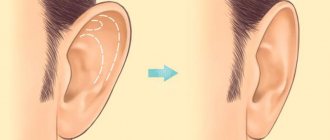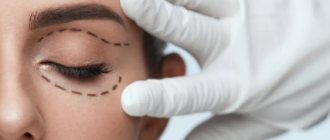Photos before and after Reviews Videos Rehabilitation Prices Analyzes Questions and Answers
Beautiful earrings - how can a woman resist them? Not every woman can wear small, inconspicuous earrings most of the time. But, as a rule, beautiful earrings often turn out to be voluminous and heavy for our ears. As a result, initially neat holes in the ears inevitably increase over time .
Photos before and after restoration of a torn earlobe see other photos
An equally important aesthetic problem for a woman is a torn earlobe . A rupture of the earlobe may be due to the fact that the earring was pulled strongly, or it got caught on something and thereby provoked a rupture. Often, the first thing a woman experiences when she sees a torn earlobe is shock. Then fears begin to torment that the scar from this rupture will remain for life. It should also be noted that sometimes a torn earlobe heals, but does not heal.
But these days, these aesthetic problems can be easily solved with the help of plastic surgery.
Women often come to our clinic because the holes in their ears become large due to the weight of their earrings. The natural desire of these women is to reduce the holes in their ears, and in the future, re-pierce their ears. It is also common for women to have earrings torn off from their ears, resulting in a torn earlobe.
Preparation for otoplasty
Before eliminating defects and restoring the size of the earlobe, the patient must visit a surgeon. The attending physician will determine the complexity of the clinical case, outline and familiarize the patient with the preliminary examination plan, the progress of surgical treatment of the ear and the course of the recovery period.
Ear surgery will have to be rescheduled or canceled if the patient:
- acute infectious and oncological diseases;
- chronic diseases in the stage of decompensation;
- inflammatory processes in the intended area of otoplasty;
- acute cardiovascular pathologies;
- individual intolerance to drugs used in the otoplasty process;
- blood clotting disorder;
- menstruation, pregnancy and lactation (in women);
- decompensated thyroid diseases, etc.
Earlobe contouring
In addition to surgical correction, to eliminate aesthetic imperfections of the earlobes that are not associated with tears and stretched holes, contour plastic methods are also used - filler injections. With the help of fillers (preparations of hyaluronic acid and calcium hydroxyapatite) you can replenish lost volume, correct asymmetry, and add elasticity to age-related deformation of the lobe.
View this post on Instagram
Publication from the VECTOR and GRADIENT Clinic (@vector_gradient)
How is earlobe reconstruction surgery performed?
The doctor determines the technique of the earlobe restoration surgery in advance depending on the characteristics of the clinical case and the level of aesthetic requirements of the patient. It is worth noting that, in accordance with the general aesthetic criteria for the location of the auricle, the earlobe should:
- have a length of no more than 1.5-2 cm;
- positioned so that its attachment point is at the level of the tip of the nose;
- have edges running parallel to the branches of the lower jaw.
Surgery to restore and create the normal shape of the earlobe may require removal of the patient's excess skin or cartilage tissue, plastic surgery with local tissue, and subsequent correction of the ear to achieve complete symmetry.
The procedure for reconstructing deformed or missing areas of the ear lasts no more than 60 minutes, on an outpatient basis and using anesthesia. At the end of the operation, when the earlobe is modeled, the doctor applies a cosmetic suture and then covers the area of surgical manipulation with a sterile bandage to avoid unwanted infection and damage to the operated surface.
Sewing a puncture in the ear after tunnels is not an easy task even for an experienced surgeon
By and large, sewing up an ear after tunnels is about the same as sewing up a torn ear. Correctly and accurately removing tunnels from the ears is an operation much more delicate and complex than plastic surgery of a stretched lobe due to age-related sprains or after wearing heavy jewelry.
In the second case, simply excision of the scar is necessary. In the case of tunnels, this is not enough. To sew up a hole in the ear, you will need to cut out a flap of skin: this is the only way to collect the tissue stretched by the tunnel into a neat lobe and recreate its natural, voluminous shape.
Expert comment:
“I am often asked if it is possible to sew up the earlobe after the tunnel so that it is not noticeable. Having extensive experience in such operations, I confirm that this is quite possible. At Platinental we use a whole range of special technologies to produce thin, invisible scars.”
Maxim Vasiliev, plastic surgeon.
However, as always, there are nuances.
Reconstruction of earlobes in St. Petersburg
At the medical center, patients in need of earlobe reconstruction can undergo a medical examination, receive advice and undergo surgery to restore the shape of the ear. The clinic’s specialists have extensive practical experience; they have medical rooms equipped with the best modern equipment at their disposal - this makes it possible to individually select the surgical technique and its implementation in order to obtain the best result.
An earlobe reconstruction operation performed by our specialists will allow you to return the natural beauty and harmony to your image. The price of reconstructive operations depends on the type and degree of deformation of the auricle. You can make an appointment with our specialists using the numbers listed on the website. We are waiting for you at the address: St. Petersburg, Vasilievsky Island 10-line, no. 21 (Vasileostrovsky district, Vasileostrovskaya metro station).
How to sew up ear tunnels without scars and maintain a beautiful earlobe
It seems that it is difficult to sew up holes, what problems can arise here?
Expert comment:
“Sewing up the lobes after the tunnel is not so easy. This is a technically complex and delicate operation. It is very important that it be performed by a qualified plastic surgeon.
The consequences of unprofessional attempts can be more harmful than the holes themselves. What is this harm? The shape of the ears changes. The ears become deformed, become too flat or, conversely, become excessively elongated.
After such unprofessional attempts they come to me, but fixing such ears is more difficult and ultimately more expensive.”
Andrey Iskornev, plastic surgeon.
In order to avoid all these troubles, the doctor must create a “pattern” from the tissues of the lobe so that it fits you perfectly. It's like a puzzle: each piece must fit very clearly into place, otherwise nothing will work out.
The operation is performed under local anesthesia and takes from half an hour to an hour. The stitches are removed after about 5-6 days.
After this, the wound is sealed with a special skin glue, which allows you to wash your hair and lead a normal lifestyle.
Gradually the earlobes tighten. After two months, they can be pierced to wear earrings. The results will last a lifetime.
Non-surgical plastic surgery
Non-surgical correction techniques can be used to enlarge an underdeveloped or disproportionately small earlobe. The most popular is subcutaneous injection of fillers. In fact, this is an alternative to installing implants, but gives a temporary result that lasts 6-12 months.
Typically, gel fillers based on hyaluronic acid are used to create additional volume. The procedure consists of shallow injections that are very easily tolerated without any anesthesia. The result becomes noticeable in about a week. There is no rehabilitation period, but in the first days you must be careful so that the gel is distributed correctly.
To pull out a small lobe, you can try buying special plastic clips. But to get a noticeable effect, you will have to use them for several months continuously.
Clips must be made of hypoallergenic plastic, always with soft silicone pads. You cannot wear them for more than one hour at a time, as this can impair blood circulation.
Prevention of earlobe injuries
The most common cause of stretching and injury to the earlobe is wearing earrings. Especially if they are not smooth, but have sharp tips, hooks and protrusions that can easily get caught on clothes, hair and bed.
If you do wear earrings, listen to the advice of experts:
- for everyday wear, choose smooth and not too heavy models;
- Be sure to remove jewelry with natural stones at least at night;
- never sharply pull off hats or clothes with a narrow neck;
- in windy weather, tie long hair in a ponytail or secure with hairpins;
- Be careful when playing with small children who may pull the earrings sharply.
It is worth thinking carefully before installing tunnels. The fashion for them is already passing, and the marks, even on a corrected lobe, will remain for life. The same applies to several piercings in one ear. Not everyone heals without leaving a trace; ugly, rough scars often remain.
Rehabilitation and complications
Since lobe plastic surgery is a simple operation, it is performed on an outpatient basis, and after 15-20 minutes the patient can return home.
For several days, it is very important to follow the following doctor’s recommendations:
- exclude serious physical activity;
- avoid getting water on your earlobes when washing or washing your hair;
- treat wounds with an antiseptic several times a day;
- do not sleep on your side, so as not to damage the earlobe in your sleep;
- wear a patch fixing the new shape for up to seven days;
- do not sunbathe, do not visit the sauna and solarium;
- do not swim in pools and open water.
Swelling and minor pain usually disappear completely within 2-3 days, bruises and hematomas - within 4-6. You can safely go to work within a week. But for at least a month it is better not to touch your earlobes with your hands and not try to put on earrings.
Types of otoplasty
Among specialists in the field of plastic surgery, it is customary to distinguish several main types of plastic surgery on the ears, which depend on the purpose of plastic surgery, the technique and method of correction, the complexity of the surgical intervention and other factors.
Otoplasty, depending on the purpose of the operation, is divided into:
- Reconstructive ear surgery
– this surgical correction allows you to eliminate congenital deformities of the ears, restore the missing part of the cartilage tissue or the entire auricle. To do this, the plastic surgeon uses autografts - a section of rib cartilage and the patient's soft tissue, which guarantees almost 100% survival and minimal risks of rejection. Reconstructive otoplasty is a more complex surgical method than aesthetic ear surgery. Therefore, restoration of the auricle takes more time, and the correction itself is carried out only by experienced surgeons. In total, ear reconstruction can last from 2 months to six months, which depends on the complexity of the defect, the patient’s health and many other factors. In most cases, reconstructive otoplasty takes place in 2 successive stages: the plastic surgeon creates a special “pocket” under the skin where cartilage will be placed in the future; - The second stage of the operation is the direct formation of the outer ear.
is a surgical intervention that allows the doctor to reduce the unaesthetic size of the ear and change the shape of the auricle, give smooth contours, remove protruding ears, correct bifurcation of the lobe, etc.
Based on the method of performing the operation, otoplasty is divided into:
- Traditional ear surgery
, during which the plastic surgeon uses a scalpel. - Laser otoplasty
, which today is more popular in comparison with the classical surgical technique. - Seamless ear otoplasty
. During the operation, the plastic surgeon corrects the shape of the auricle, modeling a new type of ear. This can be done due to the excellent flexibility of cartilage tissue. During plastic surgery, the doctor makes an incision behind the ear and then removes excess skin and cartilage. There are no sutures placed on the incision. - Suture otoplasty.
Plastic surgeons use 2 types of suture otoplasty:
Mustard
. During surgery, the surgeon makes a long incision on the back of the ear and then stitches it. It is the suture material that promotes the bending of cartilage tissue, resulting in the formation of a beautiful fold of the antihelix of the auricle. - Furnas
. The surgeon excises a piece of skin behind the ear, and then sutures the cartilage tissue to the temporal bone.
. This method of performing ear surgery is used if the surgeon’s patient is a child. During surgery, the plastic surgeon removes skin. The cartilage tissue is bent back, after which it is secured in the desired position using permanent sutures.
. This method is the least traumatic, as it does not involve making cuts on the skin. A plastic surgeon performs aesthetic plastic surgery of the ears through small punctures in the skin behind the ears.
According to the degree of complexity, ear otoplasty is divided into:
- Otoplasty of the first degree of complexity
. In this case, we are talking about subtle aesthetic flaws in the relief of the ears. During plastic surgery, the surgeon removes excess cartilage tissue, which allows the ears to be given the desired shape. - Otoplasty of the second degree of complexity
. In a patient, the doctor can detect smoothness of the helix and a deep distance of the auricle from the skull. During surgical correction, the plastic surgeon forms the folds of the antihelix. - Otoplasty of the third degree of complexity.
The most difficult type of surgical correction. Plastic surgery on the ears involves the fact that the surgeon will carry out a serious correction of the cartilage tissue during the procedure, since the patient has been diagnosed with disturbances in the anatomical structure of the auditory organ.
Otoplasty can be performed for aesthetic reasons. Therefore, the operation is classified according to the purpose of surgical correction of the ears. Otoplasty is indicated if:
- The patient has severe protruding ears
. In most cases, plastic surgeons use a suture correction method during surgery. - The patient's earlobe is injured or its size is excessive
. The duration of the operation depends on the complexity of the patient’s ear injury. When reducing the size of the lobe, the surgeon excises excess tissue and forms a new shape of the lobe. - The patient has a stretched earlobe due to a tunnel
. One of the most difficult types of otoplasty, since during the procedure the surgeon must completely close the tunnel and excise excess stretched skin. - The patient wants to have “elf ears” done
. This type of operation is very complex, as it involves changing the shape of the cartilage from semicircular to oblong with a pointed tip.
Plastic surgeons also divide aesthetic plastic surgery of the ears according to the number of operations:
- Primary surgical correction
, when the patient comes for the first time for a consultation with a plastic surgeon in order to eliminate an aesthetic defect in the ears. - Repeated otoplasty.
It is performed on the patient if the result of aesthetic correction of the ears by surgical method is not satisfactory. In most cases, repeated plastic surgery is performed for asymmetry of the ears, if a keloid scar has formed after surgery, or if the effect of the aesthetic procedure is insufficient.
Progress of the operation
The suturing of the hole after the tunnels is performed under local anesthesia. The plastic surgeon removes a small fragment of skin and soft tissue, forms regular skin flaps and sutures them so that the seam after the operation is least noticeable. For these purposes, special suture material and a special suturing technique are used.
Plastic surgery after injury includes one more stage - removal of the scar followed by suturing the edges of the wound with a cosmetic suture. When restoring the shape and size of a stretched lobe, a small fragment of tissue is also removed, but the manipulations are performed on the inside, which avoids the formation of visible scars.
You can have earlobe plastic surgery at the Soho Clinic (Moscow). The Soho Clinic plastic surgery center employs highly qualified specialists with extensive experience in complex reconstructive surgeries.
Contraindications
Contraindications are viral and bacterial infections, skin damage in the surgical area, autoimmune diseases, blood clotting problems, taking anticoagulants, individual allergic reactions to the components of drugs used during surgery.
Despite the fact that plastic surgery of the earlobes solves almost any problem, it is easier to prevent the problem than to treat it later. To avoid injury to the earlobe, experts recommend not wearing heavy earrings in your ears for a long time, and not allowing babies to play with earrings, because, as you know, their reflex actions can be unexpected and abrupt. It is better not to go to bed with bulky jewelry, and also handle earrings carefully, wearing clothes that can get caught on them. Regular cosmetic care of the area around the ears will keep the skin young and elastic for a long time. These simple precautions will prevent the need to contact a plastic surgeon.
Indications
Often, such a procedure is performed solely at the request of the patient.
The earlobe does not affect the quality of hearing, so its correction is considered an aesthetic operation. Moreover, the problem is often far-fetched, and the surgeons themselves do not see any particular need for plastic surgery. According to experts, the procedure is considered justified if:
- it is necessary to close the holes in the lobe after wearing tunnels for a long time;
- she became too elongated under the weight of heavy earrings;
- after an injury that healed on its own, a rough scar remained on the lobe;
- it is very massive in relation to the auricle itself;
- the shape became ugly after otoplasty;
- the lobe has moved too close to the cheek after a circular lift;
- it is necessary to eliminate tears or deformation from a recent injury.
Since the lobe consists of skin and fatty tissue, it is quite easy to correct. In the presence of congenital anomalies, surgery can be performed in childhood, usually 5-7 years.
Plastic surgery is also effective for eliminating sagging and other consequences of age-related changes, which are especially noticeable on previously voluminous lobes.
How does plastic surgery work?
Earlobe correction can be performed using three methods:
- contour (use of fillers);
- laser;
- surgical
The surgeon decides which method will be used, assessing the existing defects and the expected result. In most cases, even if the plastic surgery is performed with a scalpel, local anesthesia is used. General anesthesia is recommended only when complex otoplasty is performed, which involves eliminating other defects of the outer ear.
In the most severe cases, plastic surgery is performed using classical surgical methods. For example, surgery is necessary to eliminate “tunnels”. Reduction of the earlobe by tissue stretching is performed by excision of excess tissue and formation of a new earlobe.
The operation to eliminate the consequences of the “tunnels” is considered difficult. Even if the doctor manages to restore the lobe, a visible scar still remains on the tissue. Experts recommend subsequently making a piercing for regular earrings above the seam.
Complex types of correction also include the formation of the earlobe in its absence as a result of injury or a congenital anomaly. The doctor will need to create a subcutaneous pocket into which the cartilage scaffold will then be placed. The biomaterial is taken from the patient's rib. Thus, it is possible to achieve complete biocompatibility. But artificial implants can also be used. Within several months, the implanted tissue takes root. Only after this a new lobe of the correct shape is created from the already reconstructed tissues.










